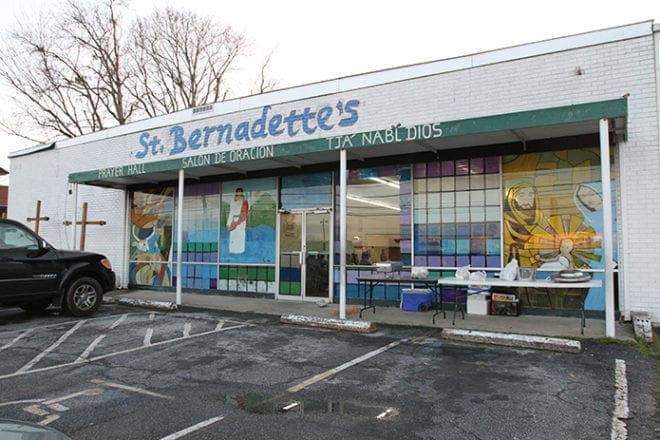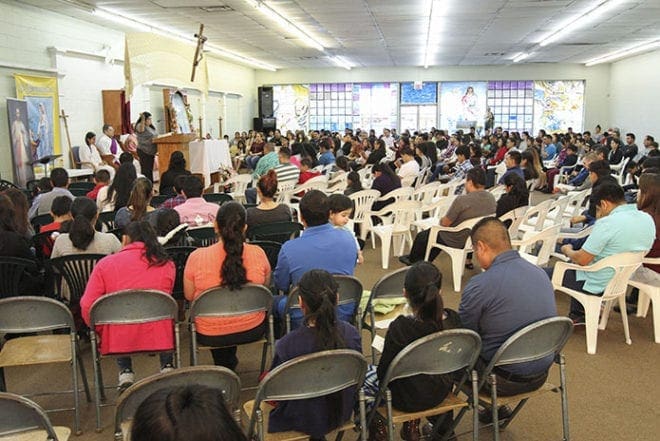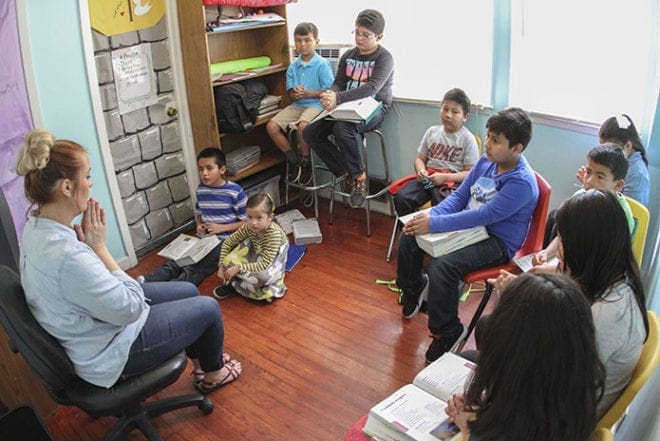 Photo By Gibbs Frazeur
Photo By Gibbs FrazeurAtlanta
Innovative program funds buildings for rapidly growing churches
By NICHOLE GOLDEN, Staff Writer | Published June 1, 2017 | En Español
ATLANTA—Making room for everyone at the Lord’s table is the spirit behind a focused new program in the Archdiocese of Atlanta.
The Special Projects Program is funding the expansion of basic worship and religious education space in a few uniquely challenged parishes whose churches cannot hold all those coming for Mass or faith education.

The congregation exits St. Bernadette Church, Cedartown, following the 10 a.m. English Mass on Sunday. The church holds just over 80 seats. Photo By Michael Alexander
The program will currently address needs in three churches—one parish and two missions in Cedartown, Gainesville and Lilburn.
The Special Projects Program is a direct outcome of the 2015 Archdiocesan Pastoral Plan. However, the need first surfaced during a strategic planning process undertaken by Archbishop Wilton D. Gregory in 2006.
“It’s a pretty long trail,” said Peter Faletti, retired director of planning for the archdiocese.
Faletti was a consultant for the North Highland Group when it was awarded the archdiocese’s strategic planning project. When the project ended in 2009, he became director of planning.
“Inside of that project, I interviewed all pastors,” said Faletti. “We went out into the field. We just let them talk, and they were very consistent.”
Faletti met with pastors initially in 2007. “It had never been done,” he explained.
Since then it has become a triennial review where priests can share issues confidentially with planning staff.
With the growth of the archdiocese in the last decade, changing demographics, and record numbers of new Catholics, many parishes are bursting at the seams.
“Everyone was feeling the challenge of growth. Everyone was feeling, ‘we’re running out of space,’” said Faletti. “You can’t create a sense of community without a space to belong.”
Growth in some locations outran the physical facility available. Some parishes and missions didn’t have enough church for the congregation and virtually no funds in the bank to remedy the situation. Several were identified where people were standing at Mass with overflow space filled to capacity. Religious education programs were unable to serve scores of additional children.

The St. Bernadette Hispanic community currently holds its liturgies in a former storefront on South College Street in Cedartown. Photo By Michael Alexander
Relieving growing pains would take an inventiveness, which Archbishop Gregory underscored in the Pastoral Plan.
The fourth pillar of the plan was “Evolution of Our Parishes,” emphasizing the need to create welcoming environments for all cultures within parishes.
“We must reallocate the resources of the archdiocese in creative ways to find and support this expansion of facilities in our high growth areas,” wrote Archbishop Gregory. “To accomplish this, our archdiocese will need to provide both financial resources and support teams.”
Faletti called this an explicit statement from the archbishop, noting it was in bold type.

Gilda Martinez, standing at the podium, a native of El Salvador, serves as lector during the 8 a.m. Sunday Spanish Mass earlier this year. St. Bernadette leases this space for the Spanish Masses. Photo By Michael Alexander
“He meant for it to be seen,” said Faletti. “We had super high growth areas without the ability to pay for what was needed.”
Responding creatively also brings out the unmet needs of fellow Catholics, he pointed out.
For example, St. Joseph Church in Dalton at one point rented space at a trailer park to help meet the spiritual needs of Catholics in its community. Later a former car dealership was procured for additional space for Masses. The result was a revelation.
“It was a very creative moment,” recalled Faletti. “Six weeks later, they were out of room.”
That’s when it occurred to him, “How many people are we not serving?”
“Follow the Acts of the Apostles”
The first meeting of SPOC, the Special Projects Oversight Committee, was in the summer of 2015, after the spring unveiling of the Pastoral Plan.
Oversight committee members designed an application process and the criteria applicants had to demonstrate—at least one year of overcrowding at Mass and in religious education programs and minimal funds to pay for expanding.
The chief financial officer of the archdiocese, Brad Wilson, was tasked with identifying funds that could be made available for the projects identified by the committee.
After a review and consultation with the Archdiocesan Finance Council, a sizable $12 million pool of funds was repositioned to the Special Projects Program, said Wilson.
“I am blessed to be the CFO for the archdiocese, and most of my work revolves around the financial matters. My involvement in SPOC allowed me to become part of a group solving an insolvable problem,” he said. “How does a community with limited means ever raise enough money to build a facility? The answer: Follow the Acts of the Apostles and spread the Gospel. We are one church.”
This initiative is funded from a combination of sources, including the mission fund; the bequest from Joseph Mitchell, nephew of author Margaret Mitchell; sale of the house on Habersham Road briefly used as an archbishop’s residence; and liquidation of other assets as needed.
Parishes or missions approved for the Special Projects Program must raise 10 percent of the cost before the remainder is funded. Once projects are complete, the first Special Projects Program recipients will pay back into the fund so that other projects can begin. A monthly rent payment to the archdiocese will lead to eventual ownership of their building.
“As the first recipients of the SPOC funding replenish the fund, more communities can be helped,” said Wilson.
“If anyone wishes to donate to this fund, I am happy to assist,” he added.
Ensuring access to the sacraments
The first three recipients are St. Bernadette Church in Cedartown, St. John Paul II Mission in Gainesville, and Our Lady of the Americas Mission in Lilburn.
“I called this my World Bank project,” said Faletti, who drafted the special projects charter. “To me, that was the concept that was needed.”

In cramped quarters, religious education instructor Bethany Nevarez, sitting left, prays with her first-year, first Holy Communion class in one of three small rooms upstairs over the main church. Photo By Michael Alexander
The program is unique among dioceses in the United States.
“I don’t think anyone is doing it exactly how we’re doing it,” noted Faletti.
Catholic Construction Services Inc. staff, led by director John Schiavone, and outside consultants Greater Mission worked with building committees of applicant parishes and missions. In a 90-day process, they worked to ascertain the real need.
“It was a huge effort,” said Faletti.
St. Bernadette, a parish since the 1950s, has experienced phenomenal growth, primarily in the Hispanic community. It has just over 80 seats in its church. Father Timothy Gallagher is the pastor.
The parish, which already owned land for a future building, has been renting storefront space but still could not accommodate growth. Between 400 and 500 people squeeze into the rented space, which is in need of repairs, to attend Mass. They are not deterred.
“They want to be there,” said Faletti.
The retired planner grew up in St. Louis, Missouri, and recalled when Cardinal Joseph Ritter announced that parishes without debt were going to help ones with debt. There was no discussion. Faletti’s childhood parish was debt-free. He remembers the pastor urging everyone to give an extra dollar for a while.
“That always stuck with me,” said Faletti. “We have a responsibility, and we need to do something about it.”
Although recipients will ultimately replenish the fund through payments, other donations will be accepted.
“I still think there are some opportunities to do fundraising for SPOC,” said Faletti.
Parishes with resources help missions in developing countries such as Haiti. He encourages strong communities to think about struggling parishes and missions that might be three counties away.
Before retiring last year, Faletti encouraged leaders to keep ahead of growth that will continue.
“If you think you’ve been growing, you have no idea,” he told them. “It’s going to put tremendous pressure on our priests. That’s why this process we put into place is so critical for the health of our archdiocese.”
If the diocese cannot provide access to the sacraments to all, “they’ll go somewhere else,” said Faletti. “It’s so basic and it’s so challenging.”
The pastoral and strategic planning processes gave Archbishop Gregory the unique opportunity to understand challenges.
“He made sure we responded,” said Faletti about the Special Projects Program. “It’s a good start, and I just hope it can grow.”
“Two young priests” foster unity
Schiavone said the projects at St. John Paul II and St. Bernadette are “mission-style” pre-engineered steel buildings, which will keep architectural, engineering and construction costs lower. The same firm will do both projects, which is more economical.

Bishop Luis R. Zarama is the first person to do the ceremonial dirt toss during the April 9 site blessing and groundbreaking for St. John Paul II Mission’s new church building in Gainesville. Clergy in the foreground applauding the moment include (l-r) Deacon Luis L. Londono, Msgr. Jaime Barona, pastor of St. Michael Church, Gainesville, Father Gerardo Ceballos, parochial vicar at St. Michael Church, and Deacon Joel Ballantyne. Photo By Michael Alexander
St. John Paul II Mission grew out of the 6,500-member St. Michael Church in Gainesville, one of the largest parishes in the archdiocese. The mission administrator is Father William Canales.
Located on Shallowford Road, the mission operates a thrift store and food bank. Mass in Spanish is celebrated on Friday and Saturday evenings with reconciliation offered before Mass. More than 1,000 people attend four Sunday Masses in its temporary facility. The mission has religious education and English language classes.
The Gainesville mission purchased property on South Smith Road. St. Bernadette already owned property on Evergreen Lane in Cedartown.
Schiavone said the planned multipurpose buildings include convertible space for worship and social events, administrative and classroom areas, and adoration chapels. Both sites have room to expand in the future or to add traditional church sanctuaries.
St. Bernadette’s new building will be able to seat 525 people for Mass. St. John Paul II will accommodate more seating.
“It’s 1,300 and they need it,” said Schiavone. “They’re going to have permanent pews.”
Site work has begun at both locations. Schiavone said the projects are expected to be complete in the summer of 2018.
St. Bernadette’s project will cost $4.6 million. The project cost at St. John Paul II is $6.4 million, which did not include land purchase.
The priests are rallying their communities and working toward greater unity.
“You’ve got two young priests and this is not easy what they’re doing,” noted Schiavone.
Standing-room-only Masses
Our Lady of Americas Mission in Lilburn will be assisted with funding for new classrooms and administrative offices through the Special Projects Program. The mission already makes full use of its sanctuary, chapel and gymnasium for Mass.
“They use it every Sunday. It’s not overflow,” said Schiavone about the gym space.
Their master plan includes a new sanctuary, but “they will be doing the sanctuary on their own,” he said. “We’re still in the design phase.”
The classrooms are a priority for Our Lady of the Americas as they offer adult formation, English language classes and religious education for children.
“Education there is huge,” said Schiavone. “They’re doing exactly what needs to be done.”
Valerie Landau was a member of the first planning committee for the archdiocese in 2006 and currently serves on the Archdiocesan Finance Council and SPOC. After a career in finance she enjoys serving the church through this work.
She said the Special Projects Program is amazing to be part of and can be far-reaching.
“One of the big thrusts for us was availability for everybody,” she said. “There are so many places where there’s the need.”
She has long studied the commitment to tithing of Protestants in the South and the idea of “blessing other people.”
“How do we engender that?” she asked.
She hopes SPOC members can create dialogue with members of the Catholic community who have knowledge of grants or foundations to build up the fund.
Many benefiting from the first round of awards are Hispanics willing to attend standing-room-only Masses.
“Some of us wouldn’t bother. That is so awe-inspiring to me,” she said. “For now, they’ve got to have a home. They come from miles around. They wait very patiently.”
Taking care of others is what Pope Francis has been challenging Catholics to do, Landau said.
Archbishop Gregory’s vision of “wanting everybody to have a place at the table” is forefront.
“That sort of drives this whole process,” she said. “What it comes down to is the body of Christ.”